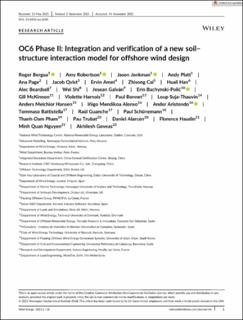| dc.contributor.author | Bergua, Roger | |
| dc.contributor.author | Robertson, Amy | |
| dc.contributor.author | Jonkman, Jason | |
| dc.contributor.author | Platt, Andy | |
| dc.contributor.author | Page Risueno, Ana Maria | |
| dc.contributor.author | Qvist, Jacob | |
| dc.contributor.author | Amet, Ervin | |
| dc.contributor.author | Cai, Zhisong | |
| dc.contributor.author | Han, Huali | |
| dc.contributor.author | Beardsell, Alec | |
| dc.contributor.author | Shi, Wei | |
| dc.contributor.author | Galvan, Josean | |
| dc.contributor.author | Bachynski-Polic, Erin Elizabeth | |
| dc.contributor.author | McKinnon, Gill | |
| dc.contributor.author | Harnois, Violette | |
| dc.contributor.author | Bonnet, Paul | |
| dc.contributor.author | Suja, Loup | |
| dc.contributor.author | hansen, anders melchior | |
| dc.contributor.author | Alonso, Iñigo Mendikoa | |
| dc.contributor.author | Aristondo, Ander | |
| dc.contributor.author | Battistella, Tommaso | |
| dc.contributor.author | Garcia, Raul Guanche | |
| dc.contributor.author | Schünemann, Paul | |
| dc.contributor.author | Pham, Thanh-Dam | |
| dc.contributor.author | Trubat, Pau | |
| dc.contributor.author | Alarcón, Daniel | |
| dc.contributor.author | Haudin, Florence | |
| dc.contributor.author | Nguyen, Minh Quan | |
| dc.contributor.author | Goveas, Akhilesh | |
| dc.date.accessioned | 2022-03-04T11:49:34Z | |
| dc.date.available | 2022-03-04T11:49:34Z | |
| dc.date.created | 2021-12-17T09:55:15Z | |
| dc.date.issued | 2021 | |
| dc.identifier.citation | Wind Energy. 2021, 1-18. | en_US |
| dc.identifier.issn | 1095-4244 | |
| dc.identifier.uri | https://hdl.handle.net/11250/2983125 | |
| dc.description.abstract | This paper provides a summary of the work done within the OC6 Phase II project, which was focused on the implementation and verification of an advanced soil–structure interaction model for offshore wind system design and analysis. The soil–structure interaction model comes from the REDWIN project and uses an elastoplastic, macroelement model with kinematic hardening, which captures the stiffness and damping characteristics of offshore wind foundations more accurately than more traditional and simplified soil–structure interaction modeling approaches. Participants in the OC6 project integrated this macroelement capability to coupled aero-hydro-servo-elastic offshore wind turbine modeling tools and verified the implementation by comparing simulation results across the modeling tools for an example monopile design. The simulation results were also compared to more traditional soil–structure interaction modeling approaches like apparent fixity, coupled springs, and distributed springs models. The macroelement approach resulted in smaller overall loading in the system due to both shifts in the system frequencies and increased energy dissipation. No validation work was performed, but the macroelement approach has shown increased accuracy within the REDWIN project, resulting in decreased uncertainty in the design. For the monopile design investigated here, that implies a less conservative and thus more cost-effective offshore wind design. | en_US |
| dc.language.iso | eng | en_US |
| dc.publisher | Wiley | en_US |
| dc.rights | Attribution-NonCommercial-NoDerivatives 4.0 Internasjonal | * |
| dc.rights.uri | http://creativecommons.org/licenses/by-nc-nd/4.0/deed.no | * |
| dc.title | OC6 Phase II: Integration and verification of a new soil–structure interaction model for offshore wind design | en_US |
| dc.type | Peer reviewed | en_US |
| dc.type | Journal article | en_US |
| dc.description.version | publishedVersion | en_US |
| dc.source.pagenumber | 1-18 | en_US |
| dc.source.journal | Wind Energy | en_US |
| dc.identifier.doi | 10.1002/we.2698 | |
| dc.identifier.cristin | 1969758 | |
| cristin.ispublished | true | |
| cristin.fulltext | original | |
| cristin.qualitycode | 2 | |

